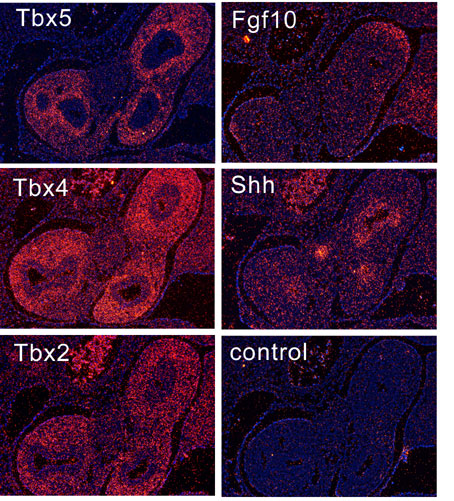Scott Gilbert

Scott Gilbert

The developing lung presents a good model system in which to study organ formation because it is composed of only two types of cells. The lining of the bronchioles and alveoli are made of epithelium, surrounded by a loosely-packed mesenchyme that functions to produce and secrete signaling molecules. These proteins bind to receptors in the cell membrane of the epithelial cells and signal them to divide and differentiate.
The epithelium of the lung is initially formed as a simple tube, which branches to form the left and right sides of the organ. Subsequently, several rounds of proliferation and branching produce a "tree" of bronchioles, and the tips expand to form the alveoli. Branching of the epithelium of the mammalian lung requires signals from the mesenchyme. The removal of the lung mesenchyme, with or without replacement by tracheal mesenchyme, results in the failure of the epithelium to branch. In contrast, bronchial mesenchyme can stimulate the formation of branches in tracheal epithelium.
The best candidate 'branching signal' is Fibroblast Growth Factor 10 (FGF10). FGF10 is expressed in patches in the mesenchyme adjacent to the site of a future branch, and it induces chemotaxis and proliferation of isolated lung epithelium. For a cell to produce such a signaling molecule, the gene that encodes it must be switched on. Transcription factors are nuclear proteins that control which genes are switched on (expressed). Therefore, the ability of a cell to send a signal to its neighbor depends on which transcription factors it has.
Several members of the T-box family of
transcription factors are expressed in the mesenchyme of the lung at
the time when cell-cell interactions are occurring (below). Expression of Tbox genes in the
mesenchyme of the developing lung. Serial paraffin
sections from an embryonic day 11.5 mouse were hybridized
with radioactive probes specific for Tbx2, Tbx4, Tbx5,Fgf10,
and Shh. The 'sense' strand of Tbx5 was used for a negative
control.


Expression of Tbx5 in the
mesenchyme of the developing lung. Isolated lungs from
embryonic day 11.5(A-C), embryonic day 12.5(D,E) and
embryonic day 13.5(F) were analysed by whole mount in situ
hybridization.
|
To analyze the function of T-box gene products during lung development, we cultured embryonic lung buds under conditions where normal lung branching procedes and added antisense oligonucleotides (oligos) to the organ cultures. Antisense oligos are short pieces of single-stranded DNA that are opposite in orientation to the RNA and thus can bind to it and target it for degradation by cellular enzymes. Two closely-related members of the T-box family, Tbx4 & Tbx5, are both expressed in lung mesenchyme. We designed an antisense oligo that can hybridize to both Tbx4 and Tbx5 mRNA. The addition of this antisense oligos results in a complete inhibition of the formation of new branches (right). |
|
|
|
We examined the specificity of the antisense oligo by isolating RNA from control and treated lungs and examinig the expression of the targeted genes (Tbx4 & Tbx5) and control genes (Tbx2 and the ribosomal protein S16 [not shown]) by reverse transcription followed by PCR. The RNA levels for Tbx4 and Tbx5 were selectively decreased. |
|
|
|
|
The inhibition of lung branching results from the loss of normal branching signals. Antisense oligo treatment resulted in the dramatic reduction of FGF-10 expression assayed by in situ hybridization (left) and semi-quantitative PCR (below). Thus, Tbx5 may control branching by regulating the levels of FGF-10.
|
|
 |
||
|
|
Furthermore, addition of FGF-10 soaked beads was able to restore branching to cultured lungs treated with antisense oligos. These data suggest that Tbx4 & Tbx5 regulate branching by helping to regulate the expression of Fgf10.
This observation is also intriguing because another T-box gene has been shown to regulate FGF expression in frog embryos. This raises the possibility that a function of T-box proteins is to control expression of signaling molecules such as the FGF family. |
|
|
|
||
Last Modified: 13 November, 2002